Territory and Land Acknowledgement
The schools of the Waterloo Region District School Board are located on the Traditional Territory/Ancestral Lands of the Haudenosaunee, Anishinaabe and Neutral People. It is important to recognize that best practices will evolve over time through engaging with the purpose and impact of these acknowledgments. For now, the following land acknowledgement is being used as the beginning of an ongoing process toward understanding our relationship to this land. It can be read by anyone and may be used as part of continuous routines at the beginning of the school day (suggested to be positioned prior to the National Anthem), and/or at the beginning of events, gatherings and meetings.
In December 2018, the students in Mr. Wilson’s Grade 5 class collaborated to interpret the WRDSB’s Territory and Land acknowledgement in order for it to resonate with our Floradale Public School students:
Here at Floradale Public School we want to thank the Haudenosaunee People for sharing this land. The land that was once promised to them in the Haldimand Proclamation. We will use this land to build a community of learners that will try to understand how the Indigenous Peoples continue to make our school and our country a better place to live and learn.
*Haudenosaunee (Ho-den-o-show-nee)
**Anishnaabe (Ah-nish-nah-bey)
For more information on the Haldimand Proclamation:
https://www.thecanadianencyclopedia.ca/en/article/haldimand-proclamation
Floradale Students Teach Each Other About Orange Shirt Day
Friday September 28, 2018 was Orange Shirt Day – a day that is annually observed across Canada. Mrs. O’Marra and her students shared their knowledge about Indian Residential Schools and the devastating impact that they continue to have on Indigenous Canadians, their families and their descendants. Students prepared and presented a skit and shared facts with their peers as they raised awareness about Indian Residential Schools.
Orange Shirt Day is observed each September 30 to honour residential school survivors, those who did not survive, and their descendants. The origin of Orange Shirt Day is based on Phyllis Webstad’s story of entering an Indian Residential School in 1973 and having her new orange shirt removed from her and replaced with a school uniform. Her experience of having her orange shirt being taken from her is symbolic of all that was taken from Indigenous peoples as a result of Indian Residential Schools and is the reason we wear orange on September 30.
For well over a century, Indian Residential Schools were used as a tool to assimilate Indigenous peoples into the dominant Canadian culture. Established in 1892 by the Canadian government, in partnership with churches, Indigenous children were often moved long distances from their families and lived at the schools. Once at school, Indigenous children were forbidden to speak their languages nor practice their cultures and traditions. Living conditions for students in Indian Residential Schools were often harsh and there was often significant emotional, physical and sexual abuse of the students.
The Mohawk Institute Residential School located in Brantford is now part of the Woodland Cultural Centre and offers guided tours of the former school site. Any fundraising efforts related to Orange Shirt Day could be directed towards the Woodland Cultural Centre’s Save the Evidence Campaign that aims to restore and maintain the residential school site.


